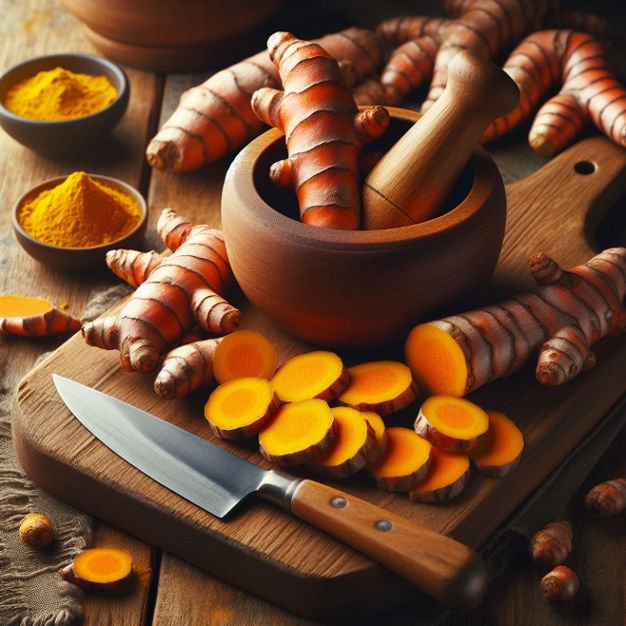Turmeric is part of the ginger family. Curcuma longa is a flowering plant from the Indian subcontinent and Southeast Asia. Turmeric has traditionally been a rich coloring and flavoring component in different Asian dishes, most notably curries. It tastes warm and bitter with a little earthy scent. Now the question is how Turmeric Uses in Cooking
Turmeric powder is a must-have in Indian biryani, soups, and stews. Turmeric is used in stir-fried dishes and soups in Vietnamese cooking. Similar to this, Thai food uses turmeric in its curries and soups.
Turmeric’s high curcumin content makes it useful for cooking, as a color, and in Ayurvedic medicine. The following are some of the ways to utilize turmeric in everyday cooking.
What Is the Use of Turmeric?
Turmeric, also known as curcumin, is often used in cuisine.
It is an essential spice in any Indian cuisine, generally accepted and utilized, even though it can turn anything from our fingertips to countertops into a variety of shades of yellow!
The color is appropriate for the name ‘Golden Spice’!! Doesn’t that sound so regal and wealthy?
In terms of application and use, turmeric certainly holds a prominent position in the culinary and herbal medicinal worlds!
So what is all this mayhem surrounding a spice about and what is the spice turmeric used for, below are some of the uses.
Stir it Into Egg-Based Recipes
Sprinkle a pinch of turmeric over any egg dish, including scrambled, omelet, frittata, or quiche. The spice will brighten your food by giving it a brilliant yellow color. Because it is not spicy hot, the taste remains unchanged.
Apply it to salads.
Turmeric powder can be used in salads in two ways. First, scatter it on top of your diced veggies. The curcumin found in turmeric aids with weight loss. When combined with black pepper, the spice helps to enhance curcumin’s absorption, increasing its potency.
The second way is to make a salad dressing with turmeric, white miso paste, lemon juice, tahini, and olive oil. Adding turmeric to the dressing makes the green salad even more nutritious.
Savor it with Soups
While the soup is cooking, add turmeric. Turmeric’s solubility and rate of absorption in the bloodstream are both improved by boiling. The spice’s therapeutic properties can be obtained while also enjoying the super-rich flavor it imparts to the soup.
Turmeric can be added to soups to help with digestion. The base for these soups is either vegetable or chicken broth. Before making the soup, add a ton of vegetables. Add more turmeric till the flavors are just right. Irritable bowel syndrome and other inflammatory bowel disorders are treated with it.
Give your rice some flavor.
A vivid yellow color is found in rice dishes like lemon rice. It’s because of the turmeric addition. Just a pinch of the spice is enough to make the rice seem quite appealing. In biryani, it is one of the ingredients. Turmeric works well with the other spices. Be careful while adding turmeric; taste first, then add more as necessary.
Prepare Nutritious Drinks
Take a warm glass of milk with a pinch of turmeric and sugar. It will undoubtedly clear your throat and provide relief from your cough and cold.
Turmeric tea is another beverage you can brew. It is a traditional Ayurvedic cure for colds and muscle aches. Black pepper, ground ginger, turmeric, and water are the only ingredients in this tea. In addition, to produce a lovely creamy golden milk latte, replace the water with oat or coconut milk.
To summarize, turmeric not only improves the color and flavor of food, but it also has therapeutic properties.
For aesthetic procedures
Turmeric paste is a traditional Indian wedding ceremony ingredient.
On the morning of the wedding, the bride and husband are coated with fresh turmeric paste for religious, health, and aesthetic purposes.
- When used in facial masks, lotions, or oils, the anti-inflammatory, antibacterial, and antioxidant characteristics can aid to:
- Bring out your natural radiance
- brighten the shadowy areas
- Benefits include preventing minor skin outbreaks, treating eczema and psoriasis, and reducing acne scars.
- lessen or impede the growth of body and face hair.
What Kinds of Turmeric Are There?

Now that you understand the applications, let’s look at the many types available to you.
There are three varieties of turmeric available on the market:
- Turmeric, either powered or ground
- Turmeric Dry root
- fresh turmeric
- They are all essentially the same, however different turmeric kinds can be used differently in cooking and other applications.
Applications for Ground Turmeric
Ground turmeric is the most popular and extensively used kind of turmeric. It is simple to use and convenient.
Scoop a tablespoon or two of turmeric powder into curries, sauces, soups, smoothies, dips, rice dishes, and stir-fries.
Turmeric can also be used to season scrambled eggs, meat, fish, and tofu marinades.
Applications of Root Turmeric
Dry turmeric is more difficult to utilize.
- A whole dry turmeric root is only used sparingly in cooking.
- The majority of uses are medical.
- This type of turmeric is hard and coarse.
- To use it in cooking, you will need to grind it into a powder. You’ll need a mortar and pestle or a decent spice grinder for this.
- Some people put a little piece of entire turmeric root in sauces and curries, then remove it before serving. But you waste a lot of turmeric in the process.
- It’s not advisable to add dry whole turmeric to smoothies either, as this could break the blade.
Once processed into powder, dry turmeric root can be used as described above.
Functions of Raw Turmeric Root
Fresh turmeric is perhaps the most pure and fresh type of turmeric that can be used in cooking.
- It is less useful than powdered turmeric but has a greater flavor and color. (Avoid getting a brighter yellow paint stain on your fingers). Peel the skin of fresh turmeric in the same way you would with ginger. The best way to scrape the skin off is using the back of a spoon.
- The remaining fresh turmeric can be stored in the refrigerator in an airtight container or covered with clingfilm. To prepare smoothies, drop in a little piece of fresh turmeric.
- Grate, grind, or prepare a paste with fresh turmeric root before using it in curries, soups, dips, muffins, pies, marinades, and milk.
- Aside from culinary use, fresh turmeric is used to make face masks and for medical purposes.
What Are Turmeric’s Negative Effects?
It is always prudent to proceed with caution, especially if you have an underlying health condition.
A daily dosage, like any supplement, will be determined by a variety of factors, including your general health, nutrition, body weight, and lifestyle.
People with gallbladder illness, iron insufficiency, diabetes, or blood difficulties should always seek medical advice before using turmeric as a health supplement rather than a spice.
Turmeric benefits for Health
Turmeric has long been utilized as a therapeutic herb in both Ayurvedic and Traditional Chinese medicine. Recent scientific research has identified curcumin, a powerful antioxidant molecule found in turmeric, as the source of its anti-inflammatory, antibacterial, and antifungal activities. Potential health advantages of curcumin include bettering cognitive function, reducing the risk of heart disease and some types of cancer, easing pain, and balancing blood sugar. However, more investigation is required to validate these assertions. Curcumin also has a low bioavailability, which means that our bodies have a difficult time absorbing and metabolizing it.
Conclusion
This colorful, well-acclaimed golden spice has conquered the world as a superfood! It was the Indian grandmothers. The go-to solution for every concern related to health issues! Scientists have also investigated what makes turmeric such a miraculous miracle spice. Turmeric is a very versatile and global cooking spice due to its flexibility and multitude of applications. It can be used to produce a variety of dishes. View the recipe area to get inspiration for your upcoming dinner. There are insufficient reports or studies to support any detrimental consequences of turmeric use. Not at all when used as a spice.
If you’re thinking about taking turmeric supplements, it’s important to use them sparingly and to certainly with a doctor.
It’s a spice of sunlight!
How do you use turmeric in everyday cooking?
A half teaspoon of ground turmeric is typically sufficient to season bean dishes, rice dishes, whole grains, soups, stews, sauces, marinades, and pickling brines. Ground turmeric can also be used to bring color to morning scrambles, creamy mac and cheese, and even cakes and sweets.
What are the 10 uses of turmeric?
Turmeric, and notably its most active ingredient, curcumin, has numerous scientifically proved health advantages, including the ability to boost heart health and prevent Alzheimer’s and cancer. It has strong antioxidant and anti-inflammatory properties. Additionally, it might lessen the signs of arthritis and sadness.
What is the purpose of turmeric powder in cooking?
“It is known for being anti-inflammatory, antimicrobial, and adds a beautiful golden color to food.” Its flavor is likewise evocative of other curries, with an earthy, bitter flavor and a hint of peppery heat.
How do you use turmeric powder daily?
Combine one part powdered turmeric with three parts raw honey. Chew a teaspoon of the combination every two hours to reduce inflammation and strengthen immunity when you sense a cold coming on. Put it in a soup.

I’m a seasoned content creator with 6+ years of experience crafting engaging, SEO-optimized content that drives traffic and rankings. I excel in keyword research, link building, and guest posting, ensuring your brand reaches new heights.

